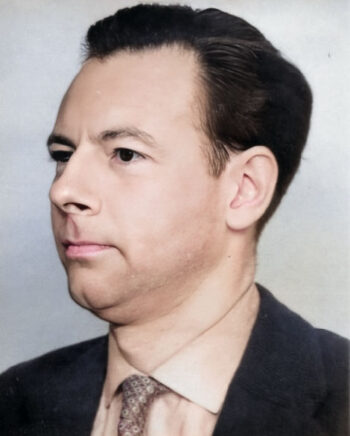Broad, Pery S.

Pery Broad (25 April 1921 – 28 Nov. 1993), SS Unterscharführer, is one of the best-known SS witnesses who provided a detailed description of an alleged homicidal gas chamber at Auschwitz. Broad was a colleague of Wilhelm Boger at the camp’s Political Department. Like Boger, Broad also penned a “confession” allegedly voluntarily written for the British, which was equally steeped in anti-fascist rhetoric parroting Allied wartime propaganda. Here an extract (Bezwinska/Czech 1984, pp. 143, 174):
“Auschwitz was an extermination camp! The biggest to exist in the history of the world. Two or three million Jews were murdered in the course of its existence. […]
The first attempt [= first gassing] at the greatest crime which Hitler and his helpers had planned and which they committed in a frightening way, never to be expiated, was successful. The greatest tragedy could then begin, a tragedy to which succumbed millions of happy people, innocently enjoying their lives!”
As the late French mainstream Auschwitz expert Jean-Claude Pressac put it (Pressac 1989, p. 128):
“But the form and tone of [Broad’s] declaration sound false. His writings cannot be the faithful reflection of the thoughts of an SS man and indeed reading them gives the impression that they were written by a former prisoner. […] Lastly, who wrote (page 172): ‘for these SS monsters, the spectacle of the suffering of ill-treated Jews constituted an amusing pastime!’ […] P. Broad’s testimony […in] its present literary form is visibly coloured by a rather too flagrant Polish patriotism.”
Although Broad never disputed that he wrote these or at least similar words, during the Frankfurt Auschwitz Show Trial, he claimed that he had merely repeated hearsay (Naumann 1965, p. 200).
Broad should have been extradited to Poland for his involvement in running the camp’s Political Department, but his “confession” saved him because it secure convictions for other defendants during the Bergen-Belsen and Tesch Trials – and by extension for the German wartime leadership and nation as such. There is one tell-tale document supporting this assumption: In the documentation about the Tesch Trial, during which Broad testified as well, the following note by the British was found (Jansson 2015):
“Perry [sic] Broad has recently given much useful information. He should therefore receive as good treatment as is possible within ALTONA Prison.”
Broad was neither extradited to Poland nor indicted by the British nor later by the West-German judiciary.
Broad’s “report” is comprehensively implausible, because his description of a gassing he claims to have witnessed is so rich in detail that he must have been omnipresent at all locations during the gassing, if it were a true account: on the roof of the gas chamber, in front of the closed gas-chamber door, and even inside the gas chamber during the execution. On the other hand, he insists on having experienced this only once while observing it from a considerable distance and from inside a different building. In other words: He must have invented all (or nearly all) of it (cf. Mattogno 2016c, pp. 57-63; Rudolf 2005; 2023, pp. 455-457). This becomes clear when we consider his description of how the corpses were arranged in the gas chamber once the door was reopened after ventilation (Bezwinska/Czech 1984, pp. 174-177, here p. 177):
“The corpses, their mouths wide open, were leaning one upon the other. […] It was difficult to tug the corpses from the mortuary, as their twisted limbs had grown stiff with the gas.”
Corpses do not go stiff from inhaling hydrogen cyanide, and it takes hours for rigor mortis to set in, so anyone dying of gas poisoning in a standing position will fall or at least slump to the ground, not keep standing, no matter how tightly the people are packed.
Other implausibilities include (for more see Graf 2019, pp. 273-281):
- The “unmistakable, penetrating stench of burnt hair,” which allegedly emanated from the crematorium chimney, cannot come out of cremation furnaces.
- Broad reported flames shooting out of the crematorium chimney, which is technically impossible.
- Gassing victims of Zyklon B supposedly turned blue, although in fact they would have turned pink.
- Broad claimed that the gassings were a secret, but all their described circumstances make this a ludicrous claim.
- Broad mentioned six Zyklon-B insertion holes in the roof of the morgue of Crematorium I, while the orthodoxy insists on four (and revisionist research shows that there were in fact none).
- Broad claimed that 4,000 people were crammed at once into the 210-m²-sized Morgues #1 of Crematoria II and III, meaning an impossible packing density of 19 people per square meter.
- According to him, the cremation muffles could burn four to six bodies at once, even though they had been designed only for one body at a time, and the small doors would not have allowed introducing more than two bodies at once.
- He claimed that the Auschwitz Camp’s records had been burned before the evacuation of the camp, when in fact some 150,000 documents were left intact, allowing us to reveal Broad’s lies.
- Broad insisted that the exhumation of corpses in Auschwitz in 1942 began after the discovery of Soviet Mass Graves in Katyn, although those graves were discovered only in April 1943. His former superior Maximilian Grabner told the same lie.
This agreement on an impossible point in two independent testimonies, since it could not stem from the witnesses, demonstrates that it must have come from the interrogators who were questioning them. In other words, here, as in many other concordances and convergences that some orthodox scholars have found in independent testimonies, these claims simply reflects all the commonplace facets of the propaganda “truth” about Auschwitz that were in circulation at the time.

You need to be a registered user, logged into your account, and your comment must comply with our Acceptable Use Policy, for your comment to get published. (Click here to log in or register.)